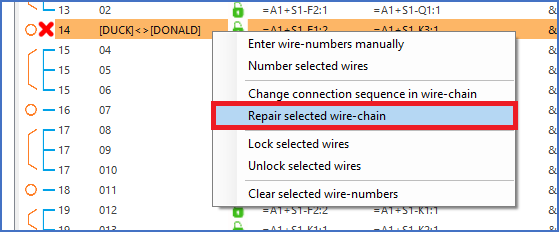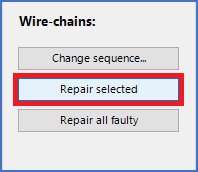|
<< Click to Display Table of Contents >> Repair selected |
  
|
|
<< Click to Display Table of Contents >> Repair selected |
  
|
This feature performs an automatic correction of all errors in a complete sub-node (a wire-chain). Since this is automatic, you have no guarantee that the result becomes exactly the way you want, but at least it is always correct. This is a good starting point for further adjustments aimed at a result that is exactly as you want it. It is easier to modify a correct wire-chain than one with errors in it.
There are two ways available to select this command:
•Right-click the erroneous wire-chain and select Repair selected wire-chain in the context menu that appears,
or
•left-click the erroneous wire-chain and click the Repair selected button in the Wire-chains section below.

Figure 2025: Right-click the wire-chain that you want to fix, and select "Repair selected wire-chain" in the context menu.

Figure 2026: Instead, you can left-click the wire-chain to fix, and click "Repair selected" under "Wire-chains" below.
cadett ELSA will then correct the chain in its own way. This means that ingoing will match outgoing everywhere. The existing wire-numbers will be used to the greatest extent possible. The result of this will be a corrected wire-chain.

Figure 2027: This is the same chain as shown before, but after it has been repaired.
Please note the blue tick to the left, where the angry error icon was shown before!
After you have corrected the wire-chain in this manner, you can transfer the corrections to the circuit diagrams. In the same way as you do that for any other changes, you click the Apply button.
Of course, you can continue working with the wire-chain in question, and further adjust both wire-numbers and wiring sequence. That is done in the way that has already been described. However, in most cases, a step-by-step approach is the one that is most likely to be successful.
The recommended tactic, is to make the correction in three separate steps:
1.Perform an automatic repair using the Repair selected wire-chain command as described here. Then save the result using Apply.
2.Correct the wiring sequence according to your own preferences using the Change sequence... command. Then save the result using Apply.
3.Correct the wire-numbers according to your own preferences using one of the methods described in the Changing wire-number topic. Then save the result using Apply.
The example shown above is extremely simple. In most cases, the reality is much more complex. That does not mean, however, that the recommended tactic changes. On the contrary!